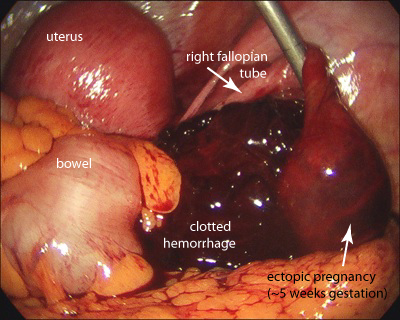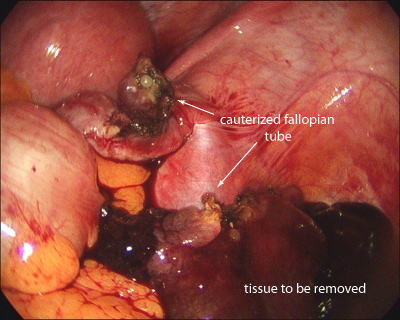
Ectopic Pregnancy
last authored: June 2009, Reuben Kiggundu
last reviewed:
Introduction
Ectopic pregnancy (Greek ektopos, or out of place) refers to the implantation of a fertilized egg outside of the uterine cavity.

laparoscopic image provided by Dr Charles Hamm
Locations include the fallopian tubes (isthmus 12%, fimbria 5%), cervix, ovary, cornual region of the uterus, and the abdominal cavity.
The abnormally implanted blastocyst grows and draws its blood supply from the site of abnormal implantation. As the gestation enlarges, it creates the potential for rupture and hemorrhage - one of its most dangerous compications.
Causes and Risk Factors
Anything that hampers the migration of the embryo to the endometrial cavity can predispose to ectopic pregnancy.
- pelvic inflammatory disease - commonest Chlamydia trachomatis (10-15% chance with future pregnancy)
- history of prior ectopic pregnancy (15-20% recurrence rate)
- history of tubal surgery and conception after tubal ligation
- use of infertility drugs or assisted reproductive technology
- use of intrauterine devices
- increasing age
- smoking
- salpingitis isthmica nodosum
- previous DES exposure
- T-shaped uterus
- prior abdominal surgery
Signs, Symptoms, and Diagnosis
- history and physical exam
- lab investigations
- diagnostic imaging
History and Physical Exam
Only 50% of patients present typically.
The classic clinical triad of ectopic pregnancy includes:
- lower abdominal pain
- amenorrhea
- vaginal bleeding
Other symptoms common to early pregnancy (nausea, breast fullness, fatigue, heavy cramping etc.)
Lab Investigations
- beta-HCG
- CBC
- Rh type
- crossmatch
Diagnostic Imaging
ultrasound
Differential Diagnosis
Other possible conditions include:
- appendicitis
- urinary tract infection
- salpingitis
- ruptured corpus luteum cyst
- threatened abortion
Pathophysiology
Damage to the cilia in Fallopian tubes may be responsible for ectopic pregnancy, caused by factors such as pelvic inflammatory disease (PID) or surgery.
Treatments

laparoscopic image provided by Dr Charles Hamm
Medications
methotrexate
Rhogam if appropriate
Non-medications
Large bore IV and fluid resuscitation
Laparatomy/laparascopy for definitive diagnosis and treatment
Consequences and Course
Ectopic pregnancy can lead to massive hemorrhage, infertility, and death.
Resources and References
